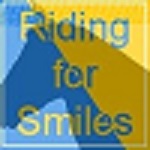A Primary school were offered a block of 6 sessions for junior aged children with additional needs. All children involved were on the additional needs register and/or receiving pupil premium funding. They had varied needs including ASD, social/emotional, language and learning difficulties. Out of all the mainstream groups we have worked with so far this group had collectively the highest needs. A number of these children worked at significantly lower levels than their age, especially in spoken and receptive language skills. All pupils were, however, excited, and eager to take part in all the activities and participated without fuss. Only one child had previously ridden so the experience was new to them.
On the first week a few of the children were expectedly quite nervous, especially when mounting the horse/pony. The children with language difficulties found it hard to follow verbal instructions and needed lots of small steps demonstrating and a great deal of patience. They all managed, however, to mount the pony successfully and after a few minutes began to relax. A couple of the children took a while to have the confidence to sit up rather than hunch over the pony and they needed gentle guidance on how to improve and sit correctly. For the stable activity I decided that for the first week this group needed to have a look around and familiarise themselves with the place. This helped them settle once they had quelled their curiosity and asked any questions they wanted answering. They were then introduced to Jack and encouraged to stroke him. All were happy to do this with encouragement and the session ended with them being confident that they could take part in grooming with an adult next week.
Over the next 4 weeks this group progressed significantly. They grew slowly in confidence and were able to mount the pony more swiftly and then sit relaxed and in a good position. The 2 children who originally sat hunched over began to sit in a more upright position and were happy enough to look around and chat while riding. During stable activities, the children learned the names of some brushes but needed constant reminding of what each was used for and how to use them correctly. They confidently took part in grooming the pony, though their concentration was short and so another activity was also undertaken during the same session, such as filling hay nets and collecting muck. With guidance the children were able to work together on these tasks, sharing, taking turns, and helping each other.
This group of children were given a hack out each week which was good in the sense that it was a calming therapeutic activity for them all. It also gave them the chance to get used to the feel of the pony’s movements and gain confidence, all of which was beneficial and helped raise the children’s self-esteem.
